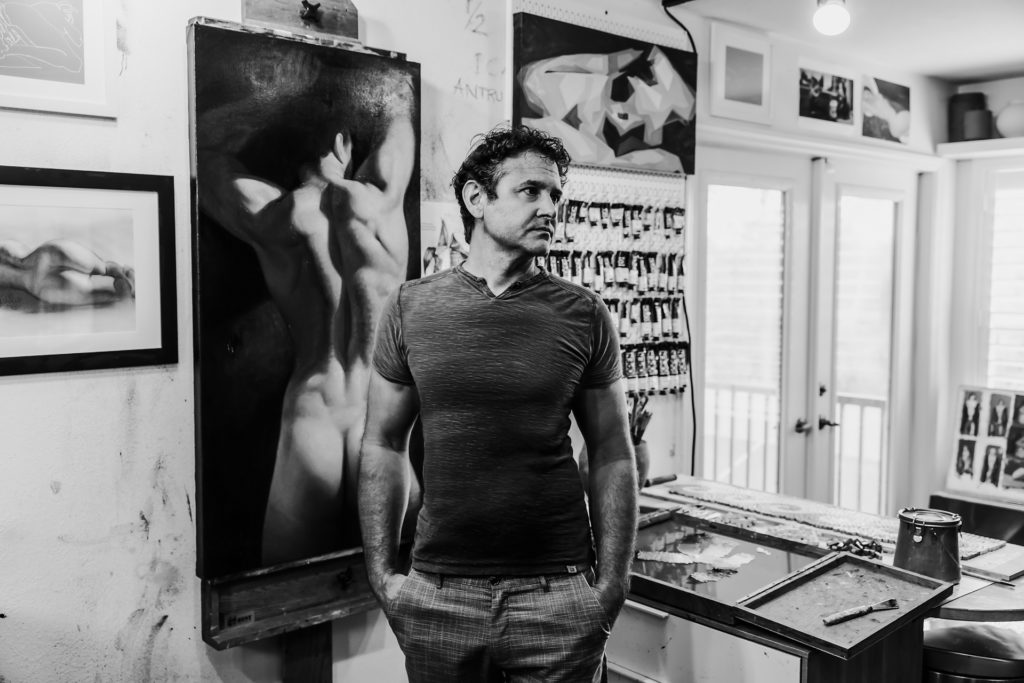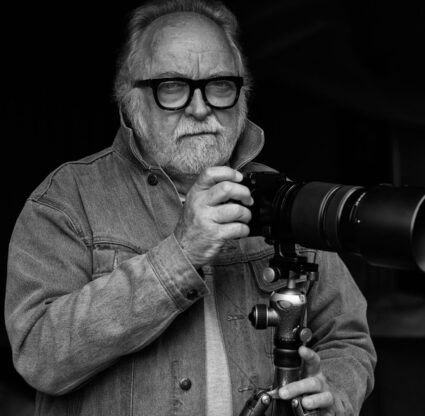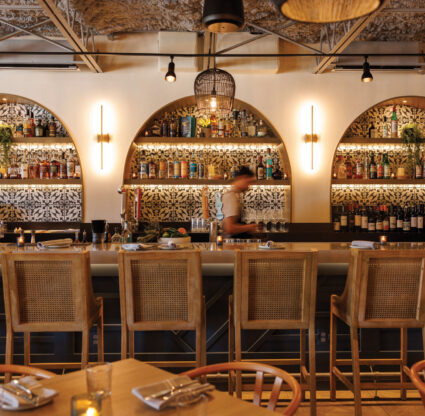Francesco Gillia keenly recalls a mole depicted on Pluto’s back in 17th-century Italian sculptor Gian Lorenzo Bernini’s The Rape of Proserpina in Rome’s Galleria Borghese. The rough-cut bump seems all too intentional against the gleaming surface. The Fort Myers-based artist grew up in the Cavalli Romani, a cluster of villages just outside the Eternal City. He spent a lot of time studying Bernini’s work. “The light catches that one imperfection,” Francesco says. “He was describing a god but still made it human.”
Francesco dials in on such irregularities with his own figurative paintings. In his 11-year-old Pronaos series, 12 large-scale oils portray a range of female bodies—cellulite, spots and wrinkles included—from upper rib cages to shins. “I didn’t Photoshop them. I just gave them a loving light,” he says. The artist strategically illuminates belly buttons and thighs, with carmine pigment laced throughout so that even the deepest folds of skin blaze with color. He’s often reluctant to showcase the pieces, aware that audiences might interpret the nude figures as profane or sexualized.
Francesco Gillia threw caution to the wind this fall, displaying selections from Pronaos at Sidney & Berne Davis Art Center. Rather than hanging the canvases on the towering walls of the center’s first-floor Grand Atrium gallery, he opted for the second-floor Capital Gallery to take advantage of the cleverly placed windows that peek out at the stately columns that span the front of the art center. “You also appreciate better how the figures become architectural,” Francesco says. “The large scale and uniformity of the canvases make the bodies look like columns.” This architectural effect inspired the series title. “The pronaos is the transitional space between the outside and inside of a church,” Francesco says. “I especially thought of the entrance to the Pantheon.” Francesco’s subjects stand colossal, flanking viewers like the Roman temple’s Corinthian columns stand sentinel over tourists.
Before Francesco Gillia began the series in 2010, he studied art in Rome and briefly worked in product design in Southern California, where he met his wife. They moved to Montana shortly after getting married and joined his brother to launch Bottega Montana, a furniture and woodworking company that garnered attention from The New York Times and clients like Lamar Odom and Khloé Kardashian.
In 2008, the tanking economy halted Bottega Montana’s meteoric success. Francesco and his wife enrolled in graduate school at Montana State University in Bozeman. With three young children to support, they were lured by the university’s ability to provide housing, stipends and stability, even if on a shoestring budget. For Francesco, the change proved serendipitous. He’d been yearning to return to art. “I was ready to go back to painting; I just needed the excuse,” he says.
As part of his graduate thesis, Francesco Gillia had free rein to decide who, what and how he would paint. He was drawn to ideas surrounding birth and life after seeing his three kids being born. “I was a witness to their creation,” he recalls. “The miracle happens inside the woman.” Two artworks kept resurfacing in his mind: the 25,000-year-old Venus of Willendorf, a statuette of a fertility goddess, and Leonardo da Vinci’s hauntingly accurate diagrams of fetuses inside their mother’s wombs. Soon after, he posted a flyer in his studio window, looking for figurative models to pose for free; about two dozen people responded to the call. “The women who showed up were fed up with society and how they were expected to look,” he says. The models reminded him of the sinuous Venus of Willendorf. “In Italian, ‘sinuoso’ describes a subject with lots of curves, like water flowing, but it also means fascinating. By the eighth or ninth painting, my ideas tightened up,” he adds.
Francesco sketched his models when schedules allowed and worked from photographs when they weren’t around. Before each painting, he’d sketch a flurry of thumbnails, conducting color studies to break down neutral skin tones into mosaic-like swatches of lavender and ochre. To better understand what lies underneath the bodies’ high points and crevasses, he drew anatomical diagrams, annotating the musculature under the skin. He then painted the final pieces in oil, which mirrors the tactility and glow of skin. “The greasiness and translucence of oil paint was the best thing to describe the human body,” he says.
Each Pronaos painting measures around 6 feet tall and 4 feet wide. When mounted on a wall, the subjects’ pelvises stand at eye level for most adult viewers. “I wanted to put the viewer back in the mind of a 4-year-old kid, but I can’t shrink the viewer,” Francesco explains. If the paintings are large enough to reduce viewers to the size of children, he reasoned, maybe the audience could see the figures as a child would, with untainted curiosity and wonder. “A 4-year-old’s innocence sees the human body without any negative ideas,” he says.
Light also plays a crucial role in glorifying Francesco’s figures. His Pronaos subjects shine with serene, golden rays cascading over the undulating forms of their abdomen, thighs and knees. The light’s spectral luminosity emphasizes that the bodies aren’t naked but rather bare; they’re not vulgar but revered. “The idea that sacred light is light from above, light that’s divine,” he says. The glow reveals the subjects’ sanctity and prompts viewers to contemplate the human desire to be revered. “Humans are not perfect,” he says. “But we strive for that divinity.”





